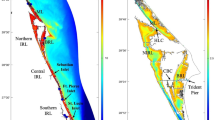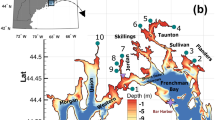Abstract
As a multi-branch estuary system, the Yangtze Estuary presents distinctive characteristics of hydrodynamic processes through co-action among river runoff, tides, wind-waves, and gravitational circulation. To study the pathways of flushing water along all of the estuary’s branches and analyze their differences, especially those due to the influence of seawater intrusion and discharge variations, a free surface flow modeling suite TELEMAC-MASCARET involving passive tracers was applied to the Yangtze Estuary and the adjacent waters. The open boundary conditions were provided by the Nao.99b model (Matsumoto et al., 2000), which was calibrated using observed velocity and salinity data obtained in March 2002. The water age, which was used as the diagnostic tool to study the flushing efficiency of the water body across the estuary, was solved by additional advection- diffusion- reaction equations implemented in the TELEMAC modeling system. The transport properties were investigated under different river discharge scenarios, which represented seasonal impacts; aspects relating to the influence of tide, surface wind stress, and density-induced circulation on age were also investigated. Model results showed that river runoff is one of the dominant factors influencing the spatial distribution of the mean age, while tidal force is another important factor. The horizontal freshwater age distribution demonstrated similarity compared with the salinity distribution; the vertical age distribution resembled the stratification pattern of salinity in all branches where stratification persists. An experimental numerical simulation of tracing saltwater age from the lower reaches of the estuary was conducted, and implicated the connectivity with transport processes of freshwater from upstream. Additionally, a particle tracking algorithm was used to analyze the dynamic characteristics of the four passages. The South Passage and South Channel were found to be significant as main water flow passages, while salinity intrusion in the North Branch was found to cause a return flow that partially joins the South Branch flushing water.
Similar content being viewed by others
References
Allen, J. I., Somerfield, P. J., and Gilbert, F. J., 2007. Quantifying uncertainty in high–resolution coupled hydrodynamicecosystem models. Journal of Marine Systems, 64: 3–14. DOI: 10.1016/j.jmarsys.2006.02.010.
Chen, S., 2003. Tidal bore in the north branch of the Changjiang Estuary. Interntional Conference on Estuaries and Coasts, Hangzhou, China, 233–239.
Chen, S., Chen, J., and Gu, G., 2003. The tidal bore at the north branch of Changjiang Estuary and its effects on the estuary. Journal of East China Normal University (Natural Science), 2: 74–80 (in Chinese).
de Brye, B., de Brauwere, A., Gourgue, O., Delhez, E. J. M., and Deleersnijder, E., 2013. Reprint of water renewal timescales in the Scheldt Estuary. Journal of Marine Systems, 128: 3–16. DOI: 10.1016/j.jmarsys.2012.03.002.
Deleersnijder, E., Campin, J. M., and Delhez, E. J. M., 2001. The concept of age in marine modelling I. Theory and preliminary model results. Journal of Marine Systems, 28: 229–267. DOI: 10.1016/S0924–7963(01)00026–4.
Delhez, E. J. M., and Deleersnijder, E., 2002. The concept of age in marine modelling II. Concentration distribution function in the English Channel and the North Sea. Journal of Marine Systems, 31: 279–297. DOI: 10.1016/S0924–7963(01) 00066–5.
Delhez, E. J. M., and Deleersnijder, E., 2010. Residence time and exposure time of sinking phytoplankton in the euphotic layer. Journal of Theoretical Biology, 262: 505–516. DOI: 10.1016/j.jtbi.2009.10.004.
Desombre, J., Pham, C. T., Goeury, C., and Joly, A., 2016. Telemac modelling system. TELEMAC–3D software: Operating manual, Release 7.0, EDF–R&D, 1–99.
Du, J., and Shen, J., 2016. Water residence time in Chesapeake Bay for 1980–2012. Journal of Marine Systems, 164: 101–111. DOI: 10.1016/j.jmarsys.2016.08.011.
Editorial Board for Marine Atlas, 1992. Marine Atlas of the Bohai Sea, Yellow Sea and East China Sea–Hydrology. China Ocean Press, Beijing, 1–524 (in Chinese).
Fang, J., Li, Y., Sun, Z., and Deng, J., 2011. Analysis of runoff change characteristics at Datong station of Yangtze River. Water Resources and Power, 29 (5): 9–13 (in Chinese with English abstract).
Gourgue, O., Deleersnijder, E., and White, L., 2007. Toward a generic method for studying water renewal, with application to the epilimnion of Lake Tanganyika. Estuarine, Coastal and Shelf Science, 74: 628–640. DOI: 10.1016/j.ecss.2007.05.009.
Hervouet, J. M., 2007. Hydrodynamics of Free Surface Flows: Modelling with the Finite Element Method. John Wiley & Sons, Ltd., Chichester, 1–360.
Kuang, C., Liu, X., Gu, J., Guo, Y., Huang, S., Liu, S., Yu, W., Huang, J., and Sun, B., 2013. Numerical prediction of medium–term tidal flat evolution in the Yangtze Estuary: Impacts of the Three Gorges Project. Continental Shelf Research, 52: 12–26. DOI: 10.1016/j.csr.2012.10.006.
Matsumoto, K., Takanezawa, T., and Ooe, M., 2000. Ocean tide models developed by assimilating TOPEX/POSEIDON altimeter data into hydrodynamical model: A global model and a regional model around Japan. Journal of Oceanography, 56: 567–581. DOI: 10.1023/A:1011157212596.
McCarthy, R. K., 1993. Residual currents in tidally dominated, well–mixed estuaries. Tellus A: Dynamic Meteorology and Oceanography, 45 (4): 325–340. DOI: 10.3402/tellusa.v45i4. 14896.
Oke, P. R., Allen, J. S., Miller, R. N., Egbert, G. D., Austin, J. A., Barth, J. A., Boyd, T. J., Kosro, P. M., and Levine, M. D., 2002. A modeling study of the three–dimensional continental shelf circulation off Oregon. Part I: Model–data comparisons. Journal of Physical Oceanography, 32: 1360–1382. DOI: 10. 1175/1520–0485(2002)032<1360:AMSOTT>2.0.CO;2.
Qiu, C., and Zhu, J., 2013. Influence of seasonal runoff regulation by the Three Gorges Reservoiron saltwater intrusion in the Changjiang River Estuary. Continental Shelf Research, 71: 16–26. DOI: 10.1016/j.csr.2013.09.024.
Sadrinasab, M., and Kämpf, J., 2004. Three–dimensional flushing times of the Persian Gulf. Geophysical Research Letters. 31: L24301, DOI: 10.1029/2004GL020425.
Shen, J., and Haas, L., 2004. Calculating age and residence time in the tidal York River using three–dimensional model experiments. Estuarine, Coastal and Shelf Science, 61: 449–461. DOI: 10.1016/j.ecss.2004.06.010.
Shen, J., and Lin, J., 2006. Modeling study of the influences of tide and stratifications on age of water in the tidal James River. Estuarine, Coastal and Shelf Science, 68: 101–112. DOI: 10.1016/j.ecss.2006.01.014.
Shen, J., and Wang, H. V., 2007. Determining the age of water and long–term transport timescale of the Chesapeake Bay. Estuarine, Coastal and Shelf Science, 74: 585–598. DOI: 10. 1016/j.ecss.2007.05.017.
Takeoka, H., 1984. Fundamental concepts of exchange and transport timescales in a coastal sea. Continental Shelf Research, 3 (3): 322–326. DOI: 10.1016/0278–4343(84)90014–1.
Wang, B., Wang, X., and Zhan, R., 2003. Nutrient conditions in the Yellow Sea and the East China Sea. Estuarine, Coastal and Shelf Science, 58 (1): 127–136. DOI: 10.1016/S0272–7714(03)00067–2.
Wang, Y., 2011. The study of the transport timescale in the Changjiang Estuary. PhD thesis. East China Normal University, Shanghai (in Chinese).
Wang, Y., Shen, J., and He, Q., 2010. A numerical model study of the transport timescale and change of estuarine circulation due to waterway constructions in the Changjiang Estuary, China. Journal of Marine Systems, 82: 154–170. DOI: 10.1016/j.jmarsys.2010.04.012.
Wang, Y., Shen, J., He, Q., Zhu, L., and Zhang, D., 2015. Seasonal variations of transport time of freshwater exchanges between Changjiang Estuary and its adjacent regions. Estuarine, Coastal and Shelf Science, 157: 109–119. DOI: 10.1016/j.ecss.2015.03.008.
Wu, H., Shen, J., Zhu, J., Zhang, J., and Li, L., 2014. Characteristics of the Changjiang plume and its extension along the Jiangsu Coast. Continental Shelf Research, 76: 108–123. DOI: 10.1016/j.csr.2014.01.007.
Wu, H., Zhu, J., and Choi, B. H., 2010. Links between saltwater intrusion and subtidal circulation in the Changjiang Estuary: A model–guided study. Continental Shelf Research, 30: 1891–1905. DOI: 10.1016/j.csr.2010.09.001.
Wu, H., Zhu, J., Chen, B., and Chen, Y., 2006. Quantitative relationship of runoffand tide to saltwater spilling over from the North Branch in the Changjiang Estuary: A numerical study. Estuarine, Coastal and Shelf Science, 69: 125–132. DOI: 10.1016/j.ecss.2006.04.009.
Xu, B., Dimova, N. T., Zhao, L., Jiang, X., and Yu, Z., 2013. Determination of water ages and flushing rates using shortlived radiumisotopes in large estuarine system, the Yangtze River Estuary, China. Estuarine, Coastal and Shelf Science, 121–122: 61–68. DOI: 10.1016/j.ecss.2013.02.005.
Yuan, R., Wu, H., Zhu, J., and Li, L., 2016. The response time of the Changjiang plume to river discharge in summer. Journal of Marine Systems, 154: 82–92. DOI: 10.1016/j.jmarsys. 2015.04.001.
Zhang, E., Savenije, H. H. G., Chen, S., and Chen, J., 2012. Water abstraction along the lower Yangtze River, China, and its impacton water discharge into the estuary. Physics and Chemistry of the Earth, 47–48: 76–85. DOI: 10.1016/j.pce.2011.05. 002.
Zhang, W. G., Wilkin, J. L., and Schofield, M. E., 2010. Simulation of water age and residence time in New York Bight. Journal of Physical Oceanography, 40: 965–982. DOI: 10. 1175/2009JPO4249.1.
Zhu, J., 2003. Ocean Numerical Calculation Method and Numerical Model. China Ocean Press, Beijing, 1–199 (in Chinese).
Zimmerman, J. T. F., 1976. Mixing and flushing of tidal embayments in the Western Dutch Wadden Sea, Part I: Distribution of salinity and calculation of mixing time scales. Netherlands Journal of Sea Research, 10: 149–191. DOI: 10.1016/0077–7579(76)90013–2.
Acknowledgements
This research is supported by the National Natural Science Foundation of China (No. 51409093). We are grateful to reviewers’ helpful comments for improving this work.
Author information
Authors and Affiliations
Corresponding author
Rights and permissions
About this article
Cite this article
Yang, J., Kong, J. & Tao, J. Modeling the Water-Flushing Properties of the Yangtze Estuary and Adjacent Waters. J. Ocean Univ. China 18, 93–107 (2019). https://doi.org/10.1007/s11802-019-3678-z
Received:
Revised:
Accepted:
Published:
Issue Date:
DOI: https://doi.org/10.1007/s11802-019-3678-z




